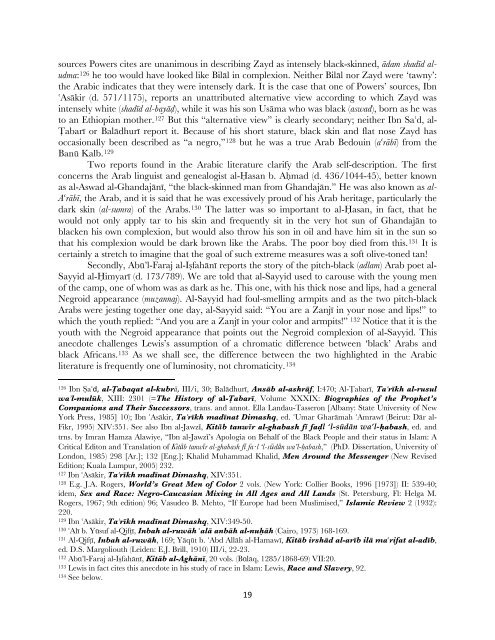“Anyone who says that the Prophet is black should be killed”: The ...
“Anyone who says that the Prophet is black should be killed”: The ...
“Anyone who says that the Prophet is black should be killed”: The ...
Create successful ePaper yourself
Turn your PDF publications into a flip-book with our unique Google optimized e-Paper software.
sources Powers cites are unanimous in describing Zayd as intensely <strong>black</strong>-skinned, §dam shadÊd aludma:<br />
126 he too would have looked like Bil§l in complexion. Nei<strong>the</strong>r Bil§l nor Zayd were ‘tawny’:<br />
<strong>the</strong> Arabic indicates <strong>that</strong> <strong>the</strong>y were intensely dark. It <strong>is</strong> <strong>the</strong> case <strong>that</strong> one of Powers’ sources, Ibn<br />
#As§kir (d. 571/1175), reports an unattributed alternative view according to which Zayd was<br />
intensely white (shadÊd al-bay§∙), while it was h<strong>is</strong> son Us§ma <strong>who</strong> was <strong>black</strong> (aswad), born as he was<br />
to an Ethiopian mo<strong>the</strong>r. 127 But th<strong>is</strong> “alternative view” <strong>is</strong> clearly secondary; nei<strong>the</strong>r Ibn Sa#d, al-<br />
•abarÊ or Bal§dhurÊ report it. Because of h<strong>is</strong> short stature, <strong>black</strong> skin and flat nose Zayd has<br />
occasionally <strong>be</strong>en descri<strong>be</strong>d as “a negro,” 128 but he was a true Arab Bedouin (a#r§bÊ) from <strong>the</strong><br />
Banå Kalb. 129<br />
Two reports found in <strong>the</strong> Arabic literature clarify <strong>the</strong> Arab self-description. <strong>The</strong> first<br />
concerns <strong>the</strong> Arab lingu<strong>is</strong>t and genealog<strong>is</strong>t al-\asan b. AÈmad (d. 436/1044-45), <strong>be</strong>tter known<br />
as al-Aswad al-Ghandaj§nÊ, “<strong>the</strong> <strong>black</strong>-skinned man from Ghandaj§n.” He was also known as al-<br />
A#r§bÊ, <strong>the</strong> Arab, and it <strong>is</strong> said <strong>that</strong> he was excessively proud of h<strong>is</strong> Arab heritage, particularly <strong>the</strong><br />
dark skin (al-sumra) of <strong>the</strong> Arabs. 130 <strong>The</strong> latter was so important to al-\asan, in fact, <strong>that</strong> he<br />
would not only apply tar to h<strong>is</strong> skin and frequently sit in <strong>the</strong> very hot sun of Ghandaj§n to<br />
<strong>black</strong>en h<strong>is</strong> own complexion, but would also throw h<strong>is</strong> son in oil and have him sit in <strong>the</strong> sun so<br />
<strong>that</strong> h<strong>is</strong> complexion would <strong>be</strong> dark brown like <strong>the</strong> Arabs. <strong>The</strong> poor boy died from th<strong>is</strong>. 131 It <strong>is</strong><br />
certainly a stretch to imagine <strong>that</strong> <strong>the</strong> goal of such extreme measures was a soft olive-toned tan!<br />
Secondly, Abå’l-Faraj al-Ißfah§nÊ reports <strong>the</strong> story of <strong>the</strong> pitch-<strong>black</strong> (adlam) Arab poet al-<br />
Sayyid al-\imyarÊ (d. 173/789). We are told <strong>that</strong> al-Sayyid used to carouse with <strong>the</strong> young men<br />
of <strong>the</strong> camp, one of <strong>who</strong>m was as dark as he. Th<strong>is</strong> one, with h<strong>is</strong> thick nose and lips, had a general<br />
Negroid appearance (muzannaj). Al-Sayyid had foul-smelling armpits and as <strong>the</strong> two pitch-<strong>black</strong><br />
Arabs were jesting toge<strong>the</strong>r one day, al-Sayyid said: “You are a ZanjÊ in your nose and lips!” to<br />
which <strong>the</strong> youth replied: “And you are a ZanjÊ in your color and armpits!” 132 Notice <strong>that</strong> it <strong>is</strong> <strong>the</strong><br />
youth with <strong>the</strong> Negroid appearance <strong>that</strong> points out <strong>the</strong> Negroid complexion of al-Sayyid. Th<strong>is</strong><br />
anecdote challenges Lew<strong>is</strong>’s assumption of a chromatic difference <strong>be</strong>tween ‘<strong>black</strong>’ Arabs and<br />
<strong>black</strong> Africans. 133 As we shall see, <strong>the</strong> difference <strong>be</strong>tween <strong>the</strong> two highlighted in <strong>the</strong> Arabic<br />
literature <strong>is</strong> frequently one of luminosity, not chromaticity. 134<br />
126 Ibn ‘a#d, al-•abaqat al-kubr§, III/i, 30; Bal§dhurÊ, Ans§b al-ashr§f, I:470; Al-•abarÊ, Ta"rÊkh al-rusul<br />
wa"l-mulåk, XIII: 2301 (=<strong>The</strong> H<strong>is</strong>tory of al-•abarÊ, Volume XXXIX: Biographies of <strong>the</strong> <strong>Prophet</strong>’s<br />
Companions and <strong>The</strong>ir Successors, trans. and annot. Ella Landau-Tasseron [Albany: State University of New<br />
York Press, 1985] 10); Ibn #As§kir, Ta"rÊkh madÊnat Dimashq, ed. #Umar Ghar§mah #AmrawÊ (Beirut: D§r al-<br />
Fikr, 1995) XIV:351. See also Ibn al-Jawzī, Kitāb tanwīr al-ghabash fī fa∙l ‘l-sūdān wa’l-Èabash, ed. and<br />
trns. by Imran Hamza Alawiye, “Ibn al-Jawzī’s Apologia on Behalf of <strong>the</strong> Black People and <strong>the</strong>ir status in Islam: A<br />
Critical Editon and Translation of Kitāb tanwīr al-ghabash fī fa∙l ‘l-sūdān wa’l-Èabash,” (PhD. D<strong>is</strong>sertation, University of<br />
London, 1985) 298 [Ar.]; 132 [Eng.]; Khalid Muhammad Khalid, Men Around <strong>the</strong> Messenger (New Rev<strong>is</strong>ed<br />
Edition; Kuala Lumpur, 2005) 232.<br />
127 Ibn #As§kir, Ta"rÊkh madÊnat Dimashq, XIV:351.<br />
128 E.g. J.A. Rogers, World’s Great Men of Color 2 vols. (New York: Collier Books, 1996 [1973]) II: 539-40;<br />
idem, Sex and Race: Negro-Caucasian Mixing in All Ages and All Lands (St. Petersburg, Fl: Helga M.<br />
Rogers, 1967; 9th edition) 96; Vasudeo B. Mehto, “If Europe had <strong>be</strong>en Muslim<strong>is</strong>ed,” Islamic Review 2 (1932):<br />
220.<br />
129 Ibn #As§kir, Ta"rÊkh madÊnat Dimashq, XIV:349-50.<br />
130 #AlÊ b. Yåsuf al-QifãÊ, Inbah al-ruw§h #al§ anb§h al-nuȧh (Cairo, 1973) 168-169.<br />
131 Al-QifãÊ, Inbah al-ruw§h, 169; Y§qåt b. #Abd All§h al-HamawÊ, Kit§b irsh§d al-arÊb il§ ma#rifat al-adÊb,<br />
ed. D.S. Margoliouth (Leiden: E.J. Brill, 1910) III/i, 22-23.<br />
132 Abå’l-Faraj al-Ißfah§nÊ, Kit§b al-Agh§nÊ, 20 vols. (Bål§q, 1285/1868-69) VII:20.<br />
133 Lew<strong>is</strong> in fact cites th<strong>is</strong> anecdote in h<strong>is</strong> study of race in Islam: Lew<strong>is</strong>, Race and Slavery, 92.<br />
134 See <strong>be</strong>low.<br />
19
















